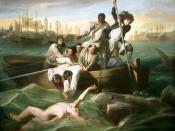John Singleton Copley's interpretation of a horrifying disaster in Brooke Watson and the Shark stands out as a romanticised horror painting. Watson and the Shark, an oil on canvas painting, was completed in 1778 and belongs to the '18th Century American political' period. The painting is an oil on canvas and stands 182 cm tall and 230 cm wide. It can be found in the National Gallery of Art in Washington .The interpretation was inspired by an event which took place in Cuba in 1749,a fourteen year-old boy ,by the name of Brook Watson was swimming unaccompanied in the harbour where he was attacked by a huge Tiger shark. His fellow shipmates ,who had been on board at the time launched to his rescue .As the sailors hurried to Watson's aid the shark repeatedly attacked the struggling boy. The shark then proceeded to bite Watson's foot off at the ankle.
Copley chooses the illustrate the moment with the highest dramatic intensity; the moment before the potentially fatal attack. Its function is to communicate a message through the cultural and subjective frames, it makes the viewers feel for the boy while at the same time informing people about the dangers associated with sharks. For Watson, the attack and recovery symbolised his triumph over misfortune, and he hoped that the painting would provide "a most useful Lesson to Youth."
The serene harbour scene in the background serves as a foil for the furious action taking place in the foreground, Other forceful features in the foreground include the size of the shark extending far beyond the boundaries of the picture frame, the movement of the boat towards the boy and the violent thrust of the boat hook. Copley uses variation in line and texture to exaggerate the sensation of the churned up...


